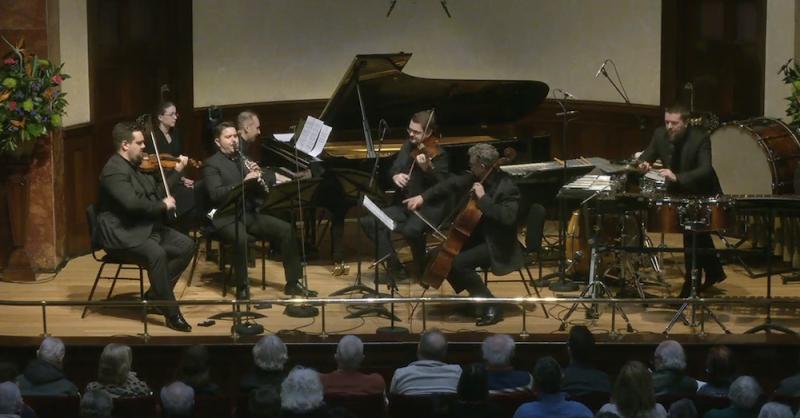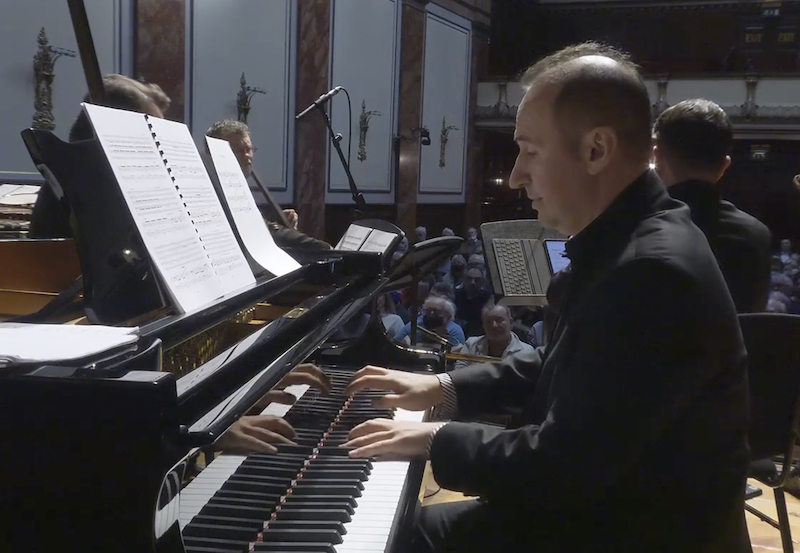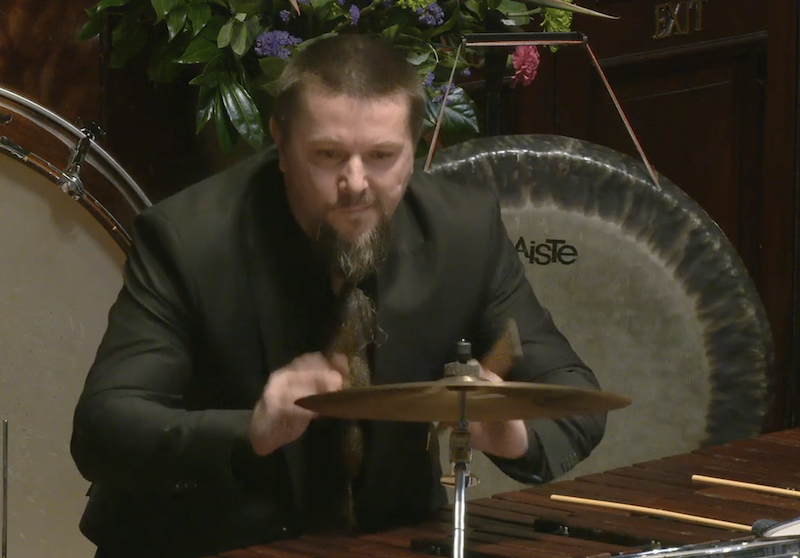Simon Trpčeski and Friends, Wigmore Hall online review – chamber music classics old and new | reviews, news & interviews
Simon Trpčeski and Friends, Wigmore Hall online review – chamber music classics old and new
Simon Trpčeski and Friends, Wigmore Hall online review – chamber music classics old and new
Quicksilver Connesson follows meaty Brahms and a Macedonian collaboration

The main course of this Wigmore lunchtime concert was Brahms but I was lured in by the dessert: a rare chance in this country to hear the music of the French composer Guillaume Connesson.
Sadly I was unable to be there in person, but caught the stream on the Wigmore’s website – their streaming of concerts that began during Covid seems to have become a permanent thing – and the concert is also available on BBC Sounds: I would strongly recommend having a look.
Brahms’s meaty third Piano Quartet was inspired by Goethe’s The Sorrows of Young Werther and also perhaps by the young composer’s complex relationship with Robert and Clara Schumann. Its rhetoric is forceful, not least in the scherzo, with Trpčeski as muscular here as he was gentle in the slow movement – and then thunderous in the double octaves of the finale. Violist Sorin Spasinovici was authoritative in his moments in the spotlight, and cellist Alexander Somov sang out his slow movement theme exquisitely. The group worked as a real collective, without any sense of Trpčeski (pictured above) – undoubtedly the ‘big name’ – being the frontman. Their playing was characterful and big-hearted, the music familiar, paving the way for some novelty.
The group worked as a real collective, without any sense of Trpčeski (pictured above) – undoubtedly the ‘big name’ – being the frontman. Their playing was characterful and big-hearted, the music familiar, paving the way for some novelty.
Pande Shahov – not a name I knew – is a Macedonian-born London resident who has made extensive arrangements of his native folk music for this group of players, for whom he also wrote his Quintet. This saw the viola replaced with clarinet and percussion (mainly vibraphone) and the clarinet writing owed something to Messiaen’s Quartet for the End of Time, especially in the slow second movement, beautifully played by Hidan Mamudov. But for much of the piece the vibraphone felt like an outsider to the rest of the group, both musically and timbrally. It came together better in the buzzing, scurrying finale, which raced to a helter-skelter end, Vlatko Nushev’s vibes mallets flying.
I have long been a committed admirer and advocate of Guillaume Connesson (b. 1970), who is widely performed in Europe and the US but almost completely overlooked in the UK. The Divertimento is an excellent introduction to his music – although as the original version was written in 1998 a lot of ink has flowed through his pen since then. It shows his skill in instrumental scoring, his melodic sensibility and his ability to entertain. The Divertimento is an arrangement by percussionist Vlatko Nushev (pictured above) of Connesson’s Sextet, faithful to the original for the most part but adding a busy percussion part, both tuned and untuned, that feels totally in keeping with Connesson’s original conception.
The Divertimento is an arrangement by percussionist Vlatko Nushev (pictured above) of Connesson’s Sextet, faithful to the original for the most part but adding a busy percussion part, both tuned and untuned, that feels totally in keeping with Connesson’s original conception.
The first movement owes a lot (and avowedly so) to John Adams. The percussion takes on much of the original oboe line, but now on marimba or xylophone, giving it a completely different colour. The martial snare drum adds a whole other element – not least in the big-top tattoo that counted in the finale (Nushev’s own addition). The Ravelian slow movement is the gorgeous heart of the piece, and here the percussion was all about deepening the nocturnal atmosphere, through quiet bass drum booms, swelling suspended cymbal and delicate glockenspiel underpinning Mamudov’s endlessly spun-out clarinet melody. (The occasional intonation insecurities in the clarinet were the only shortcomings of the whole performance.) The last movement shows Connesson as the heir to Poulenc: witty, quirky and joyous, with a brilliant punchline ending.
Trpčski was happy to sit back in the texture with his minimalist figuration and let the others lead the way – again Spasinovici was at the centre of things – but the hero, both as arranger and hyperactive performer, was Vlatko Nushev. His arrangement was as impressive as his belted beard, and if it can lead to wider recognition of Connesson’s wonderful music in this country, so much the better.
rating
Explore topics
Share this article
The future of Arts Journalism
You can stop theartsdesk.com closing!
We urgently need financing to survive. Our fundraising drive has thus far raised £49,000 but we need to reach £100,000 or we will be forced to close. Please contribute here: https://gofund.me/c3f6033d
And if you can forward this information to anyone who might assist, we’d be grateful.

Subscribe to theartsdesk.com
Thank you for continuing to read our work on theartsdesk.com. For unlimited access to every article in its entirety, including our archive of more than 15,000 pieces, we're asking for £5 per month or £40 per year. We feel it's a very good deal, and hope you do too.
To take a subscription now simply click here.
And if you're looking for that extra gift for a friend or family member, why not treat them to a theartsdesk.com gift subscription?
more Classical music
 Hallé John Adams festival, Bridgewater Hall / RNCM, Manchester review - standing ovations for today's music
From 1980 to 2025 with the West Coast’s pied piper and his eager following
Hallé John Adams festival, Bridgewater Hall / RNCM, Manchester review - standing ovations for today's music
From 1980 to 2025 with the West Coast’s pied piper and his eager following
 Kaploukhii, Greenwich Chamber Orchestra, Cutts, St James's Piccadilly review - promising young pianist
A robust and assertive Beethoven concerto suggests a player to follow
Kaploukhii, Greenwich Chamber Orchestra, Cutts, St James's Piccadilly review - promising young pianist
A robust and assertive Beethoven concerto suggests a player to follow
 Robin Holloway: Music's Odyssey review - lessons in composition
Broad and idiosyncratic survey of classical music is insightful but slightly indigestible
Robin Holloway: Music's Odyssey review - lessons in composition
Broad and idiosyncratic survey of classical music is insightful but slightly indigestible
 Classical CDs: Wolf-pelts, clowns and social realism
British ballet scores, 19th century cello works and contemporary piano etudes
Classical CDs: Wolf-pelts, clowns and social realism
British ballet scores, 19th century cello works and contemporary piano etudes
 Bizet in 150th anniversary year: rich and rare French offerings from Palazzetto Bru Zane
Specialists in French romantic music unveil a treasure trove both live and on disc
Bizet in 150th anniversary year: rich and rare French offerings from Palazzetto Bru Zane
Specialists in French romantic music unveil a treasure trove both live and on disc
 Scottish Chamber Orchestra, Ibragimova, Queen’s Hall, Edinburgh review - rarities, novelties and drumrolls
A pity the SCO didn't pick a better showcase for a shining guest artist
Scottish Chamber Orchestra, Ibragimova, Queen’s Hall, Edinburgh review - rarities, novelties and drumrolls
A pity the SCO didn't pick a better showcase for a shining guest artist
 Kilsby, Parkes, Sinfonia of London, Wilson, Barbican review - string things zing and sing in expert hands
British masterpieces for strings plus other-worldly tenor and horn - and a muscular rarity
Kilsby, Parkes, Sinfonia of London, Wilson, Barbican review - string things zing and sing in expert hands
British masterpieces for strings plus other-worldly tenor and horn - and a muscular rarity
 From Historical to Hip-Hop, Classically Black Music Festival, Kings Place review - a cluster of impressive stars for the future
From quasi-Mozartian elegance to the gritty humour of a kitchen inspection
From Historical to Hip-Hop, Classically Black Music Festival, Kings Place review - a cluster of impressive stars for the future
From quasi-Mozartian elegance to the gritty humour of a kitchen inspection
 Shibe, LSO, Adès, Barbican review - gaudy and glorious new music alongside serene Sibelius
Adès’s passion makes persuasive case for the music he loves, both new and old
Shibe, LSO, Adès, Barbican review - gaudy and glorious new music alongside serene Sibelius
Adès’s passion makes persuasive case for the music he loves, both new and old
 Anja Mittermüller, Richard Fu, Wigmore Hall review - a glorious hall debut
The Austrian mezzo shines - at the age of 22
Anja Mittermüller, Richard Fu, Wigmore Hall review - a glorious hall debut
The Austrian mezzo shines - at the age of 22
 First Person: clarinettist Oliver Pashley on the new horizons of The Hermes Experiment's latest album
Compositions by members of this unusual quartet feature for the first time
First Person: clarinettist Oliver Pashley on the new horizons of The Hermes Experiment's latest album
Compositions by members of this unusual quartet feature for the first time

Add comment